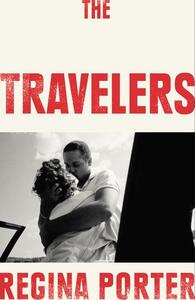Take a photo of a barcode or cover
challenging
dark
emotional
reflective
medium-paced
Plot or Character Driven:
Character
Strong character development:
Complicated
Loveable characters:
No
Diverse cast of characters:
Yes
Flaws of characters a main focus:
Yes
relaxing
medium-paced
Plot or Character Driven:
Character
Strong character development:
N/A
Loveable characters:
N/A
4 stars. The Travelers is my kind of novel: an intergenerational story told from the perspective of multiple characters. The characters of this book literally and figuratively travel around one another and their lives are interconnected in sometimes surprising ways. It takes great skill to develop so many characters and have them continously show up over 300 pages. This book may have appealed to me because I like short stories and when taken apart that is what this novel offers. All the reasons I love this book may be the reason other readers might get fatigued. A truly splendid debut by a Black woman writer.
challenging
informative
tense
fast-paced
Plot or Character Driven:
Character
Strong character development:
Complicated
Loveable characters:
No
Diverse cast of characters:
Yes
Flaws of characters a main focus:
Yes
This book is a work of art. As with all works of art it is not for everyone. It is far from a light read and far from a typical novel. The story-telling, while challenging to follow at times is brilliant and I find myself wanting to return to this large cast of characters, and this is good because I suspect one must read this book multiple times to fully appreciate it.
emotional
medium-paced
Plot or Character Driven:
Character
Strong character development:
Yes
Loveable characters:
Yes
Diverse cast of characters:
Yes
Flaws of characters a main focus:
N/A
Definitely an interesting book, but it didn't fully capture my attention and it was difficult to follow because of so many characters. The idea behind it is pretty unique though and even though it wasn't my favorite book, I think it deserves a chance.
When I opened Regina Porter's book and found at its beginning a list of 33 characters, I was immediately tempted to close it up again and reach for another book in my reading queue. But the book had been highly recommended as my "kind of book", one that I was sure to enjoy, so I persisted and immersed myself in this generational story.
All of those 33 characters turned out to be members of or connected to two families, one black and one white, and the story is a portrait of race relations in America beginning in the Jim Crow era of the 1950s and ending during Barack Obama's presidency in 2010. Moreover, as well as traveling through time, the characters travel around the world in the space of these decades. Buckner County, Georgia is central to the story, but various characters spend time in New Hampshire, New York City, Los Angeles, Vietnam, Brittany, Berlin, and the list goes on. Over time, the families become blended and interconnected through love/sex/marriage until the differences hardly seem to matter anymore. If they ever did.
The story hops and skips through time, never taking a linear course. There is no beginning, middle, and end as such. Everything blends together - like the families - over time. The story washes over the reader and finally, when one is able to view it as a whole, patterns emerge. Because of the structure of the story, it is almost impossible to summarize the plot. (Is there even a "plot"?) These characters drift together and apart through the North and South, suffering tragedies and the occasional triumph but mostly just existing in what we might call "normal lives". Porter's tale is essentially one of ordinary people who are looking to make a meaningful connection in life, one that will help them feel less alone.
I found that the proliferation of characters was never really a problem for me. If I ever began to feel confused about a particular relationship, I simply kept reading and soon I was able to make the connection I needed. Porter's writing made that easy. Her prose borders on the poetic at times. It is occasionally leavened with humor but is always filled with empathy and caring for her very human characters.
All in all, I found this another remarkable debut novel. Porter has written an intimate family portrait that could be about any of our families. It was an engrossing read. I'm glad I persisted.
All of those 33 characters turned out to be members of or connected to two families, one black and one white, and the story is a portrait of race relations in America beginning in the Jim Crow era of the 1950s and ending during Barack Obama's presidency in 2010. Moreover, as well as traveling through time, the characters travel around the world in the space of these decades. Buckner County, Georgia is central to the story, but various characters spend time in New Hampshire, New York City, Los Angeles, Vietnam, Brittany, Berlin, and the list goes on. Over time, the families become blended and interconnected through love/sex/marriage until the differences hardly seem to matter anymore. If they ever did.
The story hops and skips through time, never taking a linear course. There is no beginning, middle, and end as such. Everything blends together - like the families - over time. The story washes over the reader and finally, when one is able to view it as a whole, patterns emerge. Because of the structure of the story, it is almost impossible to summarize the plot. (Is there even a "plot"?) These characters drift together and apart through the North and South, suffering tragedies and the occasional triumph but mostly just existing in what we might call "normal lives". Porter's tale is essentially one of ordinary people who are looking to make a meaningful connection in life, one that will help them feel less alone.
I found that the proliferation of characters was never really a problem for me. If I ever began to feel confused about a particular relationship, I simply kept reading and soon I was able to make the connection I needed. Porter's writing made that easy. Her prose borders on the poetic at times. It is occasionally leavened with humor but is always filled with empathy and caring for her very human characters.
All in all, I found this another remarkable debut novel. Porter has written an intimate family portrait that could be about any of our families. It was an engrossing read. I'm glad I persisted.
A book so well-written that I highlighted many passages. Unfortunately, the format the author took, shattering the story into many pieces, and arranging them in such a way that made it hard to remember certain characters, especially minor ones that occasionally appear. Porter puts a character list at the beginning which I referred to constantly, but sometimes I just read through chapters until I found the story again.
'There's nothing new,' Mom said. 'Everything that can be done has been done already. The best we can do is reimagine our way through existence.'
This book has all the characteristics of books that I tend to love: Great characterization, alternating narrative, spanning generations/time, and surprise connections. It's hard to really summarize what it was about because it wasn't a linear story. Instead, the reader meets a new character, in their time and place, in each chapter, and eventually, the connections become clearer and the picture comes into focus. At the heart of the story, perhaps, is Agnes, and after a traumatic and devastating experience changes her trajectory, we go along for the ride to its conclusion. There is a long cast of characters, which is outlined at the beginning of the book, but the story truly revolves around James Samuel Vincent, Jr. and Agnes, and at the conclusion of the book, we see how both of these families have come full circle.
This is definitely a book that discusses race. But it also discusses homosexuality, socioeconomics, family dynamics, loyalty and history. Interspersed between the text are a host of black and white images that pertain to the stories. The novel, quite seamlessly and smoothly, discusses American issues and ideals from the 1940s all the way through 2010. It was a very different and creative take on the same sort of novel that I've been reading a lot of lately, and for that, it deserves a solid 4 stars.
This book has all the characteristics of books that I tend to love: Great characterization, alternating narrative, spanning generations/time, and surprise connections. It's hard to really summarize what it was about because it wasn't a linear story. Instead, the reader meets a new character, in their time and place, in each chapter, and eventually, the connections become clearer and the picture comes into focus. At the heart of the story, perhaps, is Agnes, and after a traumatic and devastating experience changes her trajectory, we go along for the ride to its conclusion. There is a long cast of characters, which is outlined at the beginning of the book, but the story truly revolves around James Samuel Vincent, Jr. and Agnes, and at the conclusion of the book, we see how both of these families have come full circle.
This is definitely a book that discusses race. But it also discusses homosexuality, socioeconomics, family dynamics, loyalty and history. Interspersed between the text are a host of black and white images that pertain to the stories. The novel, quite seamlessly and smoothly, discusses American issues and ideals from the 1940s all the way through 2010. It was a very different and creative take on the same sort of novel that I've been reading a lot of lately, and for that, it deserves a solid 4 stars.





